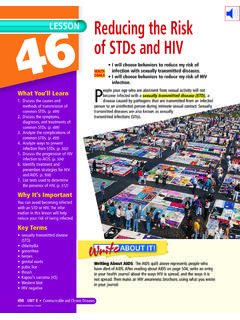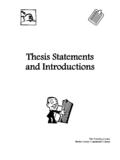Transcription of Poetry Analysis - A Step-by-step internet workshop ...
1 Poetry Analysis - A Step-by-step internet workshop Analyzing Poetry If you are just beginning to delve into the world of Poetry , you may initially feel overwhelmed by the occasional ambiguity and inaccessibility of this literary style. However, learning the elements and poetic tools used to build a poem will help to understand and analyze poems. Writing about Poetry can be difficult. A poem does not affect its reader in quite the same way that a work of prose does. To be able to understand and write about the way a poem works, you need to spend some time thinking analytically about the poem before you start your draft. Then, when you begin to write, you are better able to select appropriate evidence and construct a convincing argument. The first thing to do is to find a poem that interests you.
2 Here are some websites that you can browse through to get you started. Find a poem that is at least 25 lines long, copy it into MSWord, and print the page. Poetry Archives Poem Hunter Poetry Treasure Chest Every Poet Romantic Poetry Chinese Poetry Poet Seers Contemporary American Poetry Contemporary British and Irish Poetry Poets dot Org Electronic Poetry Center British War Poems Getting Started - take one step and a time and IN ORDER. 1) Give yourself a lot of time to read the poem several times. Read the poem aloud several times, noting its structure, meter, recurring images or themes, rhyme scheme-- anything and everything which creates an effect. 2) Paraphrase the poem: make sure you understand the language of the poem. Poetry , particularly from other time periods, often contains confusing syntax or vocabulary.
3 Put into your own words those lines or phrases which are especially difficult. Resist the temptation to brush over the lines or phrases which seem unintelligible; these can be the most crucial parts of the poem. The Oxford English Dictionary is a good resource for defining difficult vocabulary. 4) Read the poem again and jot down notes on the sheet to note every observation, question, or feeling you get from the poem as you read. Pay special attention to how the poem begins and ends. 5) Now, use your notes as entry points to begin your investigation and Analysis of the poem. Ask yourself what elements in the poem lead you to the particular observation and how the poet achieves this effect. Write down notes to yourself on each observation. Use an outline format, such as this: OUTLINE FORMAT IN MSWORD: 6) Always keep in mind that the poet uses poetic devices to achieve a particular effect.
4 Breaking up the poem into formal poetic components enhances your understanding of the poem's overall theme, tone, and/or general purpose. In other words, use form to understand the content and create a thesis about the poem. Below are some elements and corresponding poetic devices on which you can focus. Note: Many of these divisions are arbitrary. Poetic elements frequently overlap. For definitions of the underlined terms see the UWC Definitions of Poetic Devices handout. ISSUES TO ADDRESS IN YOUR OUTLINE: You will NOT use every single one, but should have a good and in-depth mix from all areas to fully analyze your poem. Choose the ones that BEST apply to YOUR poem. Content: How does the tone of the speaker and the context of the work change your understanding? 1) Speaker: Is the speaker the poet or a specific persona?
5 How is the speaker involved in the poem? Is the speaker an omniscient narrator or casual observer? Does the speaker refer to himself/ herself in the 1st person? Is the speaker from an identifiable time period? How does knowing the historical context of the poem change your understanding of the speaker's attitude? 2) Tone How is the tone of the poem developed through the language used to create imagery? How does diction influence the understanding of the tone? Does the tone change as the poem progresses? Is it consistent at the beginning and ending of the poem? 3) Tension: What is the conflict or point of tension in the poem? Is there an external or internal conflict? Physical, spiritual, moral, philosophical, social, etc? How is the tension in that conflict developed with poetic elements?
6 Is it resolved? If so, how? 4) Context: When was the poem written? What were the historical, political, philosophical, and social issues of that time? Does that change your understanding of the poem's theme? Did poets during that time period follow particular style? Is the poem consistent with the literary conventions of that era? How is it inconsistent? Language: How does the language and rhythm contribute to the meaning, purpose or emotional force? 1) Word Choice: How would you characterize the poet's word choice? Is it formal, conversational? Does the poet use a specific dialect for the speaker? 2) Meaning: What are the connotations and denotations of particular words? Are certain words repeated? Are they abstract or concrete, literal or metaphorical? 3) Rhythm: Does the poem have an identifiable rhythm arranged in the meter (iambs, spondees, trochees, )?
7 How many syllables are in each line? Does it follow a pattern? What syllables are stressed and unstressed? How does alliteration, assonance, or consonance enhance the rhythm and musicality of the poem? Imagery: How does the imagery construct the poem's theme, tone, and purpose? 1) Visuals and Sensory: Are the images literal or figurative, abstract or concrete? What sensory experiences are evoked? Are certain images repeated? 2) Metaphor: Does the poet use metaphors to make comparisons and express images or abstract ideas? Is there an extended metaphor? What is the effect of the metaphors on the tone and theme of the poem? 3) Symbolism: Are certain objects or actions developed in the imagery symbolic of an abstract idea? Do these symbols reoccur? Do they help to create an allegory?
8 Form: How does the form of the poem correspond to theme and main idea of the work? 1) Structure: Does the poem follow a formal poetic structure such as a sonnet, haiku, sestina, ode, blues poem, If so, what are the characteristics of that form? How does it deviate from that form? 2) Stanza and Lines: Are stanzas and lines consistently the same length? Do they follow a particular pattern? Are there any stanzas, lines, words, or that diverge from the pattern? 3) Rhyme Scheme: Does the poem follow an identifiable rhyme scheme corresponding to a specific poetic form? What kind of rhyme is used internal or end rhyme, slant or true rhyme, Is it consistent or scattered throughout? If not, where does the rhyme change or appear and why? What is the overall purpose or effect of the rhyme scheme?
9 Syntax: How do the poet's syntactical choices change or expand the ideas in the poem? 1) Enjambment: How are lines broken? Are they broken before a grammatical or logical completion of a thought to create an enjambment? Or are they end-stopped, breaking after the completion of a sentence or other grammatical pauses? How does the use of enjambment create a duality of meaning in the lines? 2) Verbs: Are verbs active or passive? What tense does the poet use? Is it consistent? How does tense consistency (inconsistency) affect the passage of time within the poem? 3) Sentence Structure: Does the poet use complete sentences, fragments, or a combination of both? Is there a pattern? How does the poet's sentence choices contribute to the understanding of the poem? Within the sentence, is the word order natural or grammatically irregular?
10 4) Punctuation: How is punctuation used or not used? Is it consistent with grammatical conventions? What effect does the punctuation create on how the poem is read? How does it affect the speed? Where are the pauses? Does the poet use italics, bold fonts, dashes, or any other uncommon fonts or punctuation devices? If so, why? NOW THAT YOU HAVE YOUR OUTLINE COMPLETED, HOW DO YOU TIE IT ALL TOGETHER? 1) Look through the outline that you have made and mark which of your sections are the most insightful. Which tell the most about the layers of the poem? Which ones break down the poem into its smallest pieces? Which ones bring out ideas that readers would not notice if they only read it once? Which ones show your understanding of Poetry the best? 2) Analyze the poem: Since your Analysis should make up the bulk of your essay, approach it with care.














